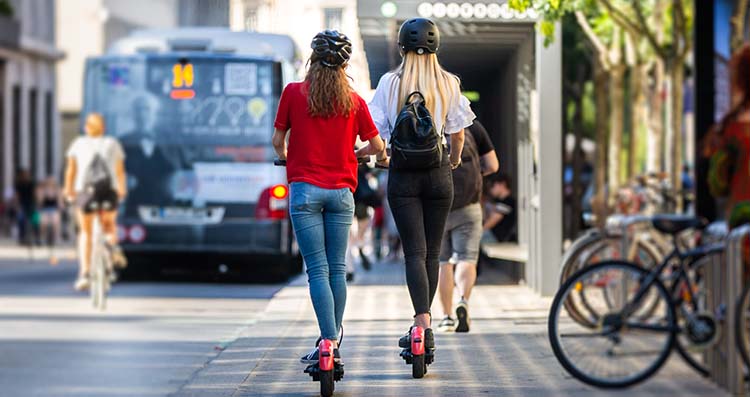Commuting: 5 trade-offs for safe and healthy mobility
Mobility is inextricably linked to the workplace – after all, don’t we all come to work together? In this article, we therefore focus on five aspects of mobility that you, as an employer, also have an impact on safety, environment, ergonomics, physical health, and mental well-being.
What’s in your mobility plan?
A large proportion of occupational accidents are related to commuting. In 2023, that was 26% of the total 40,118 declared occupational accidents (source in Dutch). So it is also in your own interest as an employer to pay attention and invest in the topic within the organisation. This can be done by raising awareness about road safety but also by offering training (e.g. e-learning about the safe use of e-mobility in Dutch or French).
In any case, include road safety in your Annual Action Plan (AAP). First, to ensure employee safety, which is a primary responsibility of any organisation. A good traffic policy can help reduce accident risks while commuting and during business travel.
Traffic accidents and incidents can primarily result in smaller or large human injury. They also entail significant costs such as medical expenses, damage to transport equipment, and loss of productivity and reputation. Developing a traffic policy can help safeguard employees’ health and minimise costs."Kleopatra Van den Bergh occupational safety expert at Mensura
Examples of measures you can include in the AAP regarding the traffic policy are:
- Implementation of a mobility plan.
- Organising road safety training for employees.
- Promotion of safe assertive driving with all modes of transport
- Encourage alternative means of transport such as cycling or public transport.

Travelling together strengthens group spirit
An organisation can reduce its carbon footprint by taking measures such as carpooling, using public transport, or encouraging cycling. This is how you show your social responsibility as a company. But what specifically can you do as an employer to reduce or avoid polluting car journeys? Three not-so-ordinary proposals!
Offer shuttle buses from the nearest station
“Is your organisation located in an industrial area or not easily accessible by public transport? Organise a shuttle from the nearest railway station to the workplace. This way, you offer your employees a practical, stress-free solution. You can potentially share the cost of such a service with other companies in the area,” says sustainability expert Matthieu Legros.
Facilitate carpooling
Carpooling is sociable and strengthens group spirit and collegiality. It’s also interesting for employees to know that they can recover part of the costs incurred via their taxes. Also, with permission, you can put employees in touch with others who are interested in carpooling.
Promote cycling
Cycling as a means of commuting has been on the rise for years. As an employer, you can offer coaching or training around cycling safety. You can also make bikes available and offer test weeks so your staff can try out a few rides before they buy a bike. The purchase can be offered in the form of a bonus or you can offer a lease plan.
Ergonomic cycling: do you know the heel method?
Have you decided that you will promote cycling? Great! But as an employer, how do you help ensure that your employees are also cycling ergonomically? Because if a bike is too big or too small, it can lead to a whole host of physical complaints. Ergonomist Jonas De Wachter gives some practical tips you can share with your employees:
- Choose the right frame size. When in doubt, choose the smallest size.
- Determine your saddle height using the heel method (see box). Even shared bikes can be adjusted correctly with this.
- If necessary, align your handlebars with your saddle (distance between the two) to avoid neck and shoulder pain.
What does the heel method involve?
The ‘heel method’ is a quick way to determine the basic saddle height. You can do this in a doorway or by leaning against a wall.
- Sit on the bike with your heel on the pedal, wearing the shoes you want to ride in.
- Pedal slowly forwards or backwards. If the saddle is too high, you won’t be able to pedal smoothly without rocking your hips or overreaching.

Read the full roadmap on how to properly adjust your bike ergonomically here.
Still travelling to work by car? Good posture is important there too! Check out some exercises here in Dutch or French.
Active commuting for physical health
Regular exercise is essential for good physical health. In fact, exercise helps prevent chronic conditions such as obesity, type 2 diabetes, dementia, and cardiovascular disease. As an employer, you can help integrate exercise into your employees’ daily work routine to promote their health, as well as create a positive work environment. Some ideas:
- Encourage active commuting: Encourage employees to walk or cycle to work. Offer facilities such as bicycle parking, showers, and changing rooms to make this choice more attractive.
- Offer parking spaces further from the entrance, so employees have to walk a bit.
- Sign yourself and your employees up for our workshop: Get healthy by moving more

Walking reduces risk of depression by 36%
How we move around also has a big impact on our mental well-being. Because did you know that people who spend more than 30 minutes in traffic jams have a 21% higher risk of chronic stress? An impressive figure, when you know Belgian residents spend an average of 39 hours a year in traffic jams (TomTom Traffic Index 2023). But public transport can also experience delays, adding to the stress.
- So get your employees to think about the best way to come to work and facilitate this where possible. Maybe someone can start working while on the train? Or avoid the rush hour by car thanks to flexible hours.
Also, many people have mainly sedentary jobs, which entails certain risks. People who sit for 6 to 8 hours a day have a 47% higher risk of symptoms of depression – even if they exercise regularly in addition. - Fortunately, regular exercise is the cure here too! So you can reduce the risk of depression by 36% just by walking 30 minutes a day. (British Journal of Sports Medicine, 2021). Walking or cycling also increases blood flow to the brain, leading to improved focus, creativity, and productivity. Motivate your employees to get off a tram or bus stop earlier or park a little further, for example.
So, as an employer, you have every interest in investing in a policy around healthy exercise, in and outside of the workplace. A comprehensive approach around these aspects of mobility will increase the well-being of your employees.
Do you have specific questions or need tips? Or interesting additions of your own?
Please let us know using the form below.